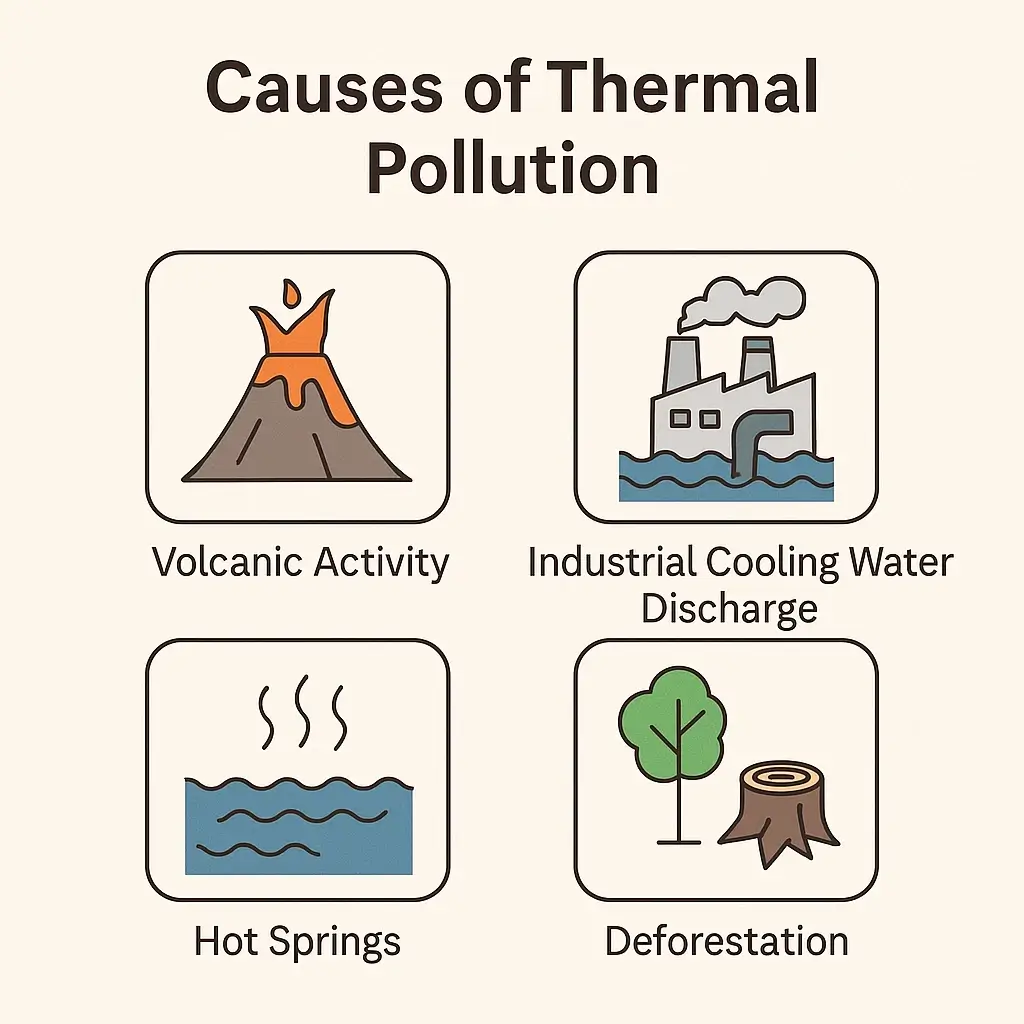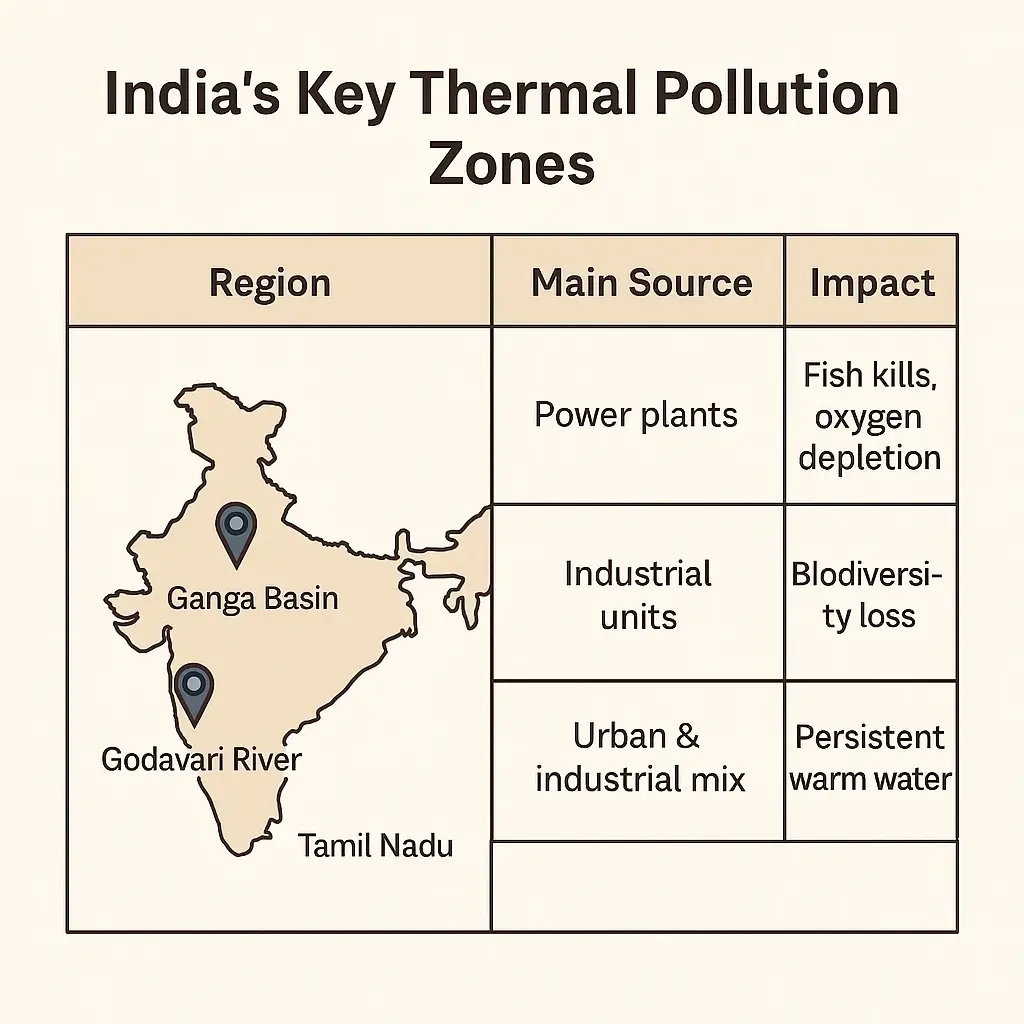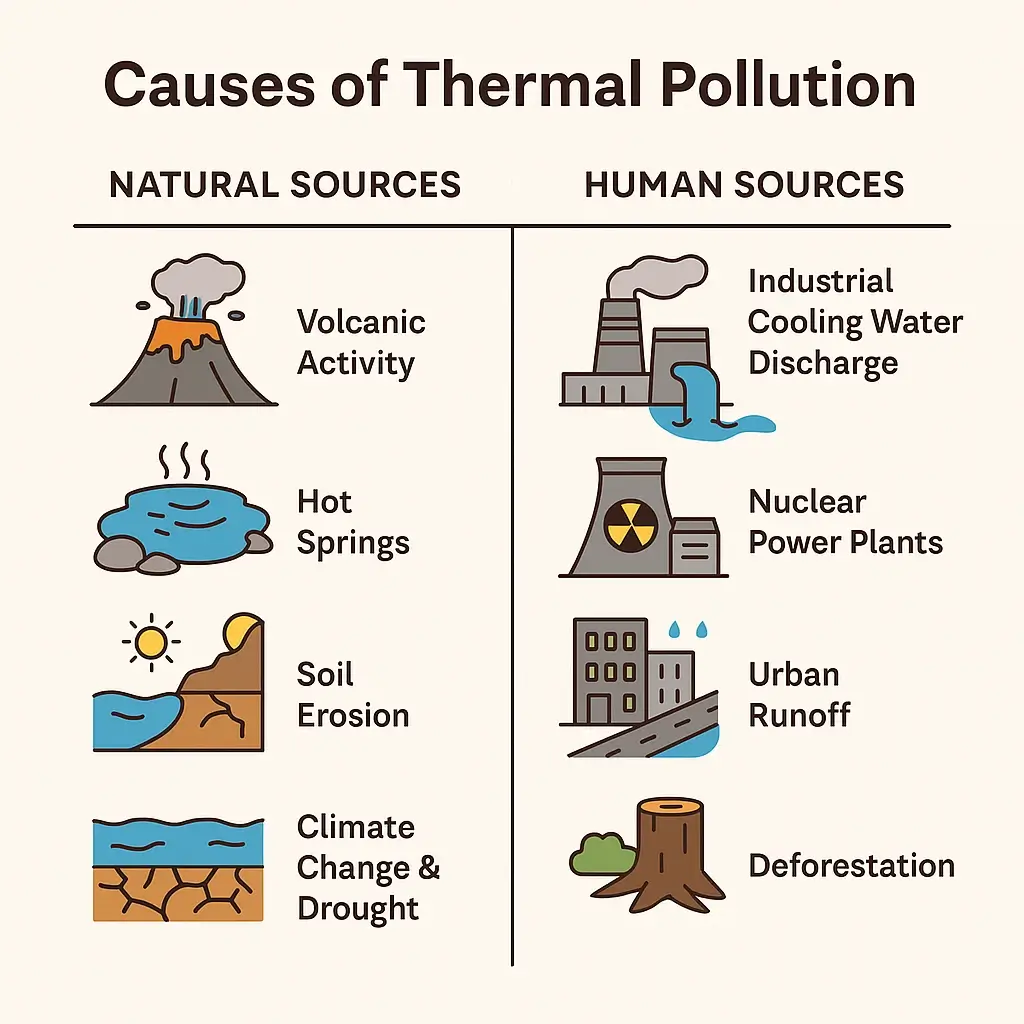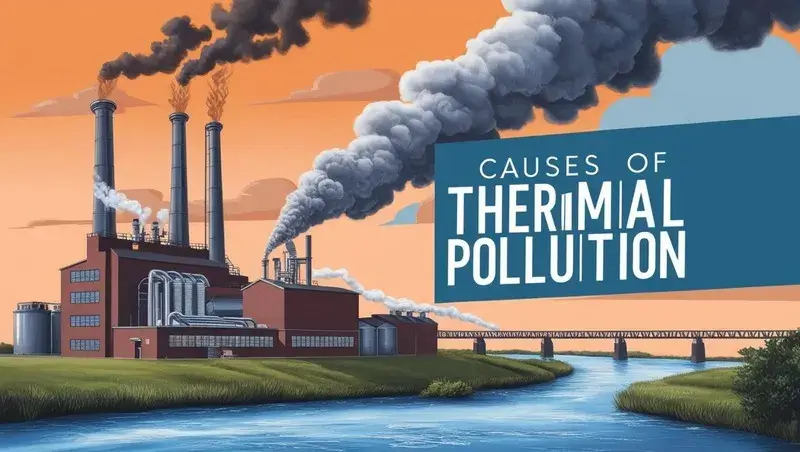Introduction:
Thermal pollution occurs when human or natural activities cause a significant rise in water temperature, harming aquatic life. Ever wondered why a river near a factory feels like a hot tub? That’s thermal pollution—and it’s silently threatening aquatic life worldwide.
This article explores the root causes of natural and human—made thermal pollution and why understanding these sources is key to practical solutions. Whether you’re a student, environmentalist, or blogger, this guide will give you a clear picture of what’s behind the rising temperatures in our lakes, rivers, and seas.
Downloadable for Students & Teachers:
Get our Thermal Pollution Classroom Handout (PDF), which includes a summary, infographic, and quiz! Perfect for school use.

Table of Contents
What Is Thermal Pollution? (Quick Recap)
Thermal pollution refers to the unnatural increase in the temperature of water bodies caused by external influences, primarily industrial or environmental activities.
It affects aquatic life, reduces oxygen levels, and disrupts the delicate balance of ecosystems. EPA.gov – Thermal Pollution Overview
Now, let’s break down who—or what—is to blame.
Global Hotspots of Thermal Pollution
While thermal pollution affects water bodies worldwide, certain regions face more severe challenges:
🔸 1. North America
The Tennessee Valley houses numerous power plants, raising river temperatures by up to 8°C.
The Columbia River basin experiences thermal stress from dams and nuclear facilities.
The Great Lakes region faces combined industrial and climate change warming.
🔸 2. Europe
The Rhine River industrial corridor receives thermal discharge across Germany, France, and the Netherlands.
Mediterranean coastal waters are warmed by desalination plants in Spain and Italy.
The North Sea faces thermal inputs from offshore operations and coastal power stations.
🔸 3. Asia-Pacific
China’s Yangtze and Yellow River basins contain the world’s highest concentration of coal plants, creating extensive thermal zones.
Japan’s coastal areas experience combined industrial and urban thermal pollution.
Australia’s Great Barrier Reef faces thermal stress from both climate change and coastal activities.
🔸 4. South America & Africa
Brazil’s Paraná River industrial centers contribute significant thermal pollution. South Africa’s coal-dependent energy sector impacts the Vaal River system. Nigeria’s Niger Delta experiences warming from oil and gas operations.
Natural Causes of Thermal Pollution
While humans play the biggest role, nature sometimes contributes too.
🔸 1. Volcanic Activity
- When lava or geothermal heat is released near water bodies, it raises water temperature dramatically.
- Common in volcanic zones like Indonesia or Iceland.
🔸 2. Hot Springs
- Natural underground heat sources feed hot springs into rivers or lakes.
- Although localized, they can affect micro-ecosystems.
🔸 3. Soil Erosion
- Heavy rains or deforestation can lead to erosion, making rivers shallower.
- Shallow waters heat faster, especially under strong sunlight.
🔸 4. Climate Change & Drought
- Long-term temperature increases make water bodies consistently warmer.
- Droughts reduce water flow, leading to stagnant, warmer conditions.
See our full guide on climate change and its effect on water bodies.
✅ Key Point: Natural causes are sporadic and usually localized, but they set the stage for human activities to cause more damage.
Human Causes of Thermal Pollution
Human activities are responsible for 90 %+ of thermal pollution cases. These are the main culprits:
🔹 1. Industrial Cooling Water Discharge
- Power plants and factories use cold water to cool machinery. IEA.org – Power Plants & Water Use
- They release the hot water back into rivers or lakes.
- This sudden spike harms aquatic organisms.
⚠️ Example: In India, thermal power plants like those in the Ganga basin discharge millions of litres of heated water daily.
🔹 2. Nuclear Power Plants
- Use vast amounts of water for reactor cooling.
- Water re-entering the ecosystem is extremely hot, often exceeding safe levels.
🔹 3. Urban Runoff
- Rainwater flows over hot rooftops and pavements, absorbing heat.
- This runoff then enters nearby water bodies, raising surface temperatures.
Learn more in our article: How Industries Affect Water Pollution
🔹 4. Deforestation
- Removing trees around rivers eliminates shade, making water more exposed to sunlight.
- The result: higher water temperatures, especially in dry seasons.
🔹 5. Construction and Mining
- Soil erosion caused by land clearing or mining fills rivers with sediment.
- Shallower water heats up faster.
🔹 6. Accidental Discharges
- Some factories discharge hot water without proper treatment due to system failures or cost-cutting.

Data Snapshot: Global and Regional Perspectives
| Region | Main Sources | Temperature Increase | Notable Impacts |
| Tennessee Valley, USA | Nuclear & coal power | 3-8°C | Bass population decline, oxygen depletion |
| Rhine River, Europe | Industrial corridor | 2-5°C | Changed migration patterns, invasive species |
| Yangtze Basin, China | Power generation | 4-9°C | Reduced aquatic biodiversity |
| Ganga Basin, India | Power plants | 6-10°C | Fish kills, oxygen depletion |
| Murray-Darling, Australia | Agriculture & urban | 1-3°C | Algal blooms, species stress |
| Niger Delta, Nigeria | Oil & gas operations | 4-7°C | Mangrove ecosystem degradation |
Data Snapshot: Thermal Pollution Impact Zones India
| Region | Main Source | Impact |
| Ganga Basin | Power plants | Fish kills, oxygen depletion |
| Godavari River | Industrial units | Biodiversity loss |
| Tamil Nadu | Urban & industrial mix | Persistent warm water |
Real-World Case Study: The Ganga Basin in India
The Ganga River basin is home to several coal-fired and thermal power plants that collectively discharge millions of litres of heated water every day. A study conducted by the National Environmental Engineering Research Institute (NEERI) found that average river temperatures near discharge points were up to 8°C higher than upstream locations.
This warming reduces dissolved oxygen levels, which has led to recurring fish kills and increased algal blooms. Local communities have reported declining fish catches and deteriorating water quality. Authorities have since mandated stricter monitoring and promoted the use of cooling ponds to mitigate these impacts, but challenges remain due to rapid industrial growth.
Human vs Natural Causes of Thermal Pollution (Comparison Table)
| Factor | Human Causes | Natural Causes |
|---|---|---|
| Frequency | Very frequent | Rare |
| Impact | Widespread | Localized |
| Control | Controllable | Not controllable |
| Examples | Power plants, urban runoff | Volcanoes, hot springs |

Global Regulatory Approaches
🔸 1. European Union
The Water Framework Directive limits temperature increases to 1.5°C for salmonid waters and 3°C for cyprinid waters.
Requires ecological quality standards for all surface waters.
Mandate cooling systems for new power plants to minimize thermal impact.
🔸 2. North America
The U.S. Clean Water Act requires thermal discharge permits through the NPDES program.
Canada’s Fisheries Act prohibits discharges harmful to fish habitats, including thermal changes.
Both countries enforce “mixing zone” regulations where discharge must meet temperature standards.
🔸 3. Asia-Pacific
Japan enforces strict thermal gradient requirements with continuous monitoring systems.
Australia incorporates thermal impacts in environmental impact assessments for coastal development.
China has recently strengthened thermal discharge regulations for power plants near major rivers.
🔸 4. India’s Regulatory Measures
India’s Central Pollution Control Board (CPCB) has issued guidelines limiting the maximum permissible temperature of effluents discharged into water bodies. Power plants are required to install cooling towers and regularly monitor discharge temperatures. The Environment (Protection) Act of 1986 empowers authorities to enforce penalties for non-compliance, and many state pollution control boards have adopted stricter local standards.
Despite these regulations, enforcement remains inconsistent. Experts argue that stronger monitoring and public reporting mechanisms are needed to reduce thermal pollution in major river systems like the Ganga and Yamuna.
🔸 5. International Agreements
The UN Convention on Biological Diversity recognizes thermal pollution as a threat to aquatic ecosystems. The Basel Convention addresses heat as a form of pollution in transboundary water systems. UNEP guidelines recommend temperature differentials not exceeding 3°C in sensitive habitats.
Conclusion:
Understanding what causes thermal pollution is the first step toward prevention. While natural events do contribute, human activities are the biggest drivers, and we have the power to change that.
By controlling industrial discharges, improving urban planning, and preserving natural landscapes, we can cool down our waters and protect aquatic life. To learn more about thermal pollution effects, check this detailed guide.
Need a Summary or Quiz for Class?
Download our free Thermal Pollution Handout PDF with an infographic, summary & mini-quiz
Frequently Asked Questions (FAQs)
What is thermal pollution in simple terms?
✅ Answer:
Thermal pollution is the rise in the temperature of water bodies caused by human activities like industrial discharge or natural events like volcanoes. It affects aquatic life by lowering oxygen levels and disrupting ecosystems.What are the main human causes of thermal pollution?
✅ Answer:
The primary human causes include industrial cooling water discharge, nuclear power plant operations, urban runoff, deforestation, construction, and accidental hot water releases.Can natural events cause thermal pollution, too?
✅ Answer:
Warmer water holds less oxygen, which can suffocate fish and other organisms. It also disrupts breeding cycles, increases algae growth, and can lead to the death of sensitive species.How can we reduce thermal pollution?
✅ Answer:
We can reduce thermal pollution by using cooling ponds or towers in industries, reforestation near water bodies, improving wastewater treatment, and enforcing environmental regulations.Is thermal pollution a major environmental issue?
✅ Answer:
Yes, it contributes to the degradation of freshwater and marine ecosystems. Though often overlooked, it plays a crucial role in climate-related water stress and biodiversity loss.Are there any laws in India addressing thermal pollution?
✅ Answer:
Yes, organizations like the Central Pollution Control Board (CPCB) regulate water discharge temperatures under environmental protection laws, especially for industries and power plants.
Want to learn more about thermal pollution?
- Read our main pillar article on thermal pollution
- Effects of Thermal Pollution on Aquatic Ecosystems
Global organizations like the United Nations emphasize the need for stricter environmental regulations to combat water pollution, including thermal pollution.
About the Author
Soumen Chakraborty is an environmental blogger and educator passionate about sustainability and hands-on learning. He creates practical guides and resources to help teachers, parents, and students explore eco-friendly activities and build a greener future together. When he’s not writing, Soumen enjoys nature walks, photography, and sharing simple ways everyone can protect the planet.
“Every small action matters in protecting our planet.”

